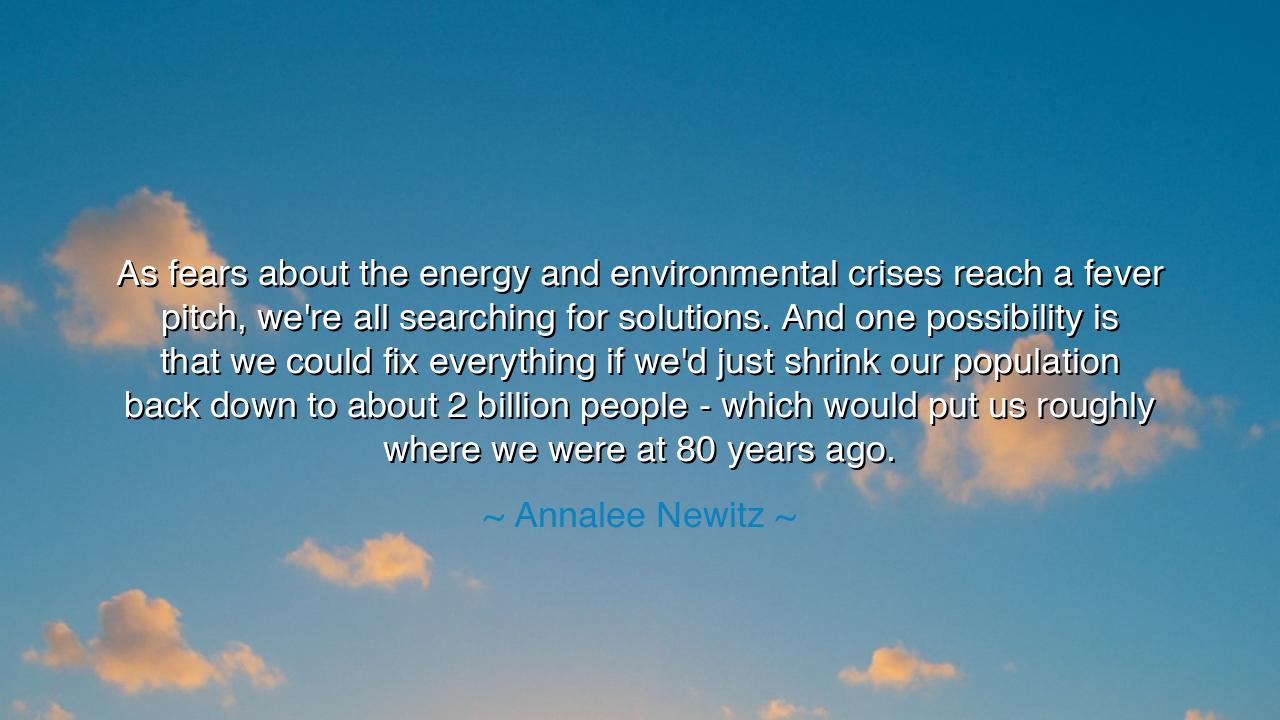
As fears about the energy and environmental crises reach a fever
As fears about the energy and environmental crises reach a fever pitch, we're all searching for solutions. And one possibility is that we could fix everything if we'd just shrink our population back down to about 2 billion people - which would put us roughly where we were at 80 years ago.






Hear the striking meditation of Annalee Newitz, who speaks to the turmoil of our age: “As fears about the energy and environmental crises reach a fever pitch, we're all searching for solutions. And one possibility is that we could fix everything if we'd just shrink our population back down to about 2 billion people – which would put us roughly where we were at 80 years ago.” These words confront us with both the magnitude of the challenge and the unsettling scale of one possible answer. They are not prophecy but provocation, a reminder that the root of many crises is not only technology or greed, but sheer numbers pressing against the limits of the earth.
At the heart of this saying lies the recognition that the energy and environmental crises are born of consumption. Each human life, though precious, carries a footprint: the food grown, the water drawn, the land used, the fuel burned. When humanity numbered in billions fewer, the earth’s balance was strained but not yet broken. Now, with over eight billion souls, the demand for resources surges beyond the planet’s ability to replenish. Newitz does not call lightly for the reduction of numbers, but rather points to the reality that population size and sustainability are bound together in a web that cannot be severed.
History bears this out with sobering clarity. In the 20th century, the population doubled and redoubled, and with it came the Green Revolution, the rise of industrial agriculture, the explosion of fossil fuel use. These marvels fed and sustained billions, but they also unleashed carbon into the skies and chemicals into the rivers. Eighty years ago, with 2 billion people, the world knew hardship and inequity, but its ecosystems still breathed freely. Today, at four times that number, we confront melting ice caps, acidifying oceans, and forests that vanish by the day. Newitz’s statement echoes this trajectory, offering the stark thought that if our numbers were fewer, our burden would be lighter.
And yet, her words are also a mirror to human fear. For who would decide which billions are to remain? What mechanism could ever achieve such a reduction without horror? Here lies the paradox: the idea is theoretically simple but morally impossible. It is not a plan to be enacted, but a truth to awaken us: that sustainability requires us to live differently, to change not only our numbers over time but our habits, our technologies, and our relationship to the earth.
There are real examples where humanity has grasped this lesson. Consider the One-Child Policy in China, enacted to curb growth. While it slowed population increase, it also revealed the heavy ethical and social burdens of forced reduction: gender imbalances, family trauma, and the curtailment of choice. The policy teaches that raw numbers cannot be the only solution; justice and dignity must guide the way. Instead, societies must look to innovation—clean energy, efficient agriculture, sustainable cities—as ways to reconcile large populations with the limits of the planet.
The wisdom of Newitz’s words lies not in prescribing reduction, but in sparking urgency. They remind us that time is short, and balance must be restored. Whether by stabilizing population growth through education and empowerment, or by reshaping the systems of energy and consumption, humanity must face the fact that the earth’s carrying capacity is finite. To ignore this truth is to invite collapse; to face it with courage is to open the door to renewal.
Therefore, children of tomorrow, take this lesson with both gravity and resolve. Do not fear the numbers alone, but fear waste, excess, and blindness. Support education, for it is the surest path to stabilizing population growth. Embrace technologies and lifestyles that reduce harm, that honor the soil and the sky. And above all, live with reverence for the limits of the earth, knowing that your choices echo across generations. In this way, the challenge posed by Newitz need not lead to despair, but to determination: to ensure that all may live well within the bounds of a living, breathing planet.






AAdministratorAdministrator
Welcome, honored guests. Please leave a comment, we will respond soon